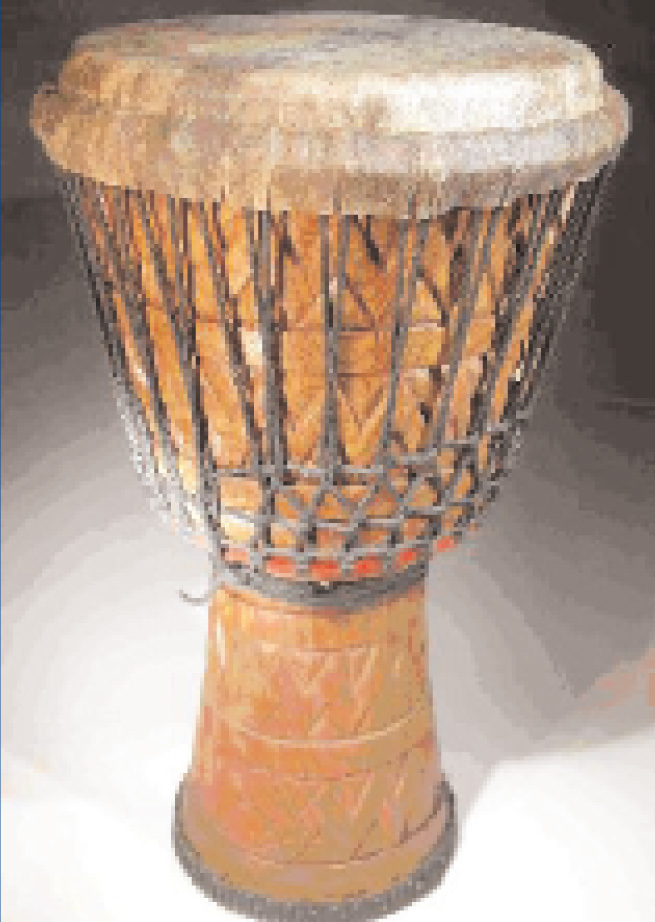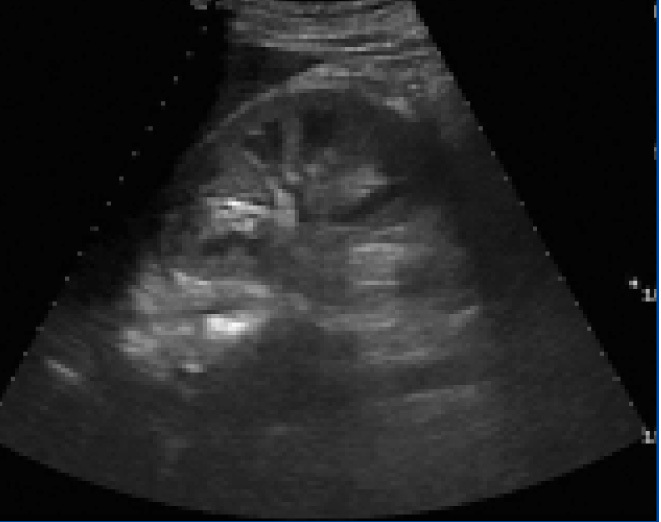To the Editor:
A 29-year-old male came to the Emergency department with abdominal pain with a 48 hour progression and diarrhoea without pathological characteristics. He informed us that he had been energetically playing African drums (dyembe, Figure 1) in the last 3 days, in sessions lasting 9 hours each, with little fluid intake, hyporexia and subsequent reddish urine. He always experiences these symptoms whenever he plays the drum. Physical exam was unremarkable: athletic body, constants within normal range. He had very positive dipstick results for blood, with urine sediment negative for erythrocytes and proteinuria of 150mg/dl, creatinine of 4.45mg/dl, urea 80mg/dl, creatine phosphokinase (CPK) of 255U/l, lactate dehydrogenase of 509U/l, compensated metabolic acidosis, normal ions and no data for anaemia. He was transferred to Nephrology where a radiograph and ultrasound (Figure 2) were performed with normal results. The patient began fluid therapy. He showed progressive worsening of renal function (creatinine of 10.49mg/dl on the fifth day) and oliguria; he did not display acute haemodialysis criteria. Renal function gradually improved until creatinine levels of 2.23mg/dl were recorded on the eighth day, in the polyuric phase; haemoglobin at admission was 14.9g/dl and at discharge it was 12g/dl, with creatinine of 1.52mg/dl. The diagnosis was acute renal failure, acute tubular necrosis in remission and haemoglobinuria. After 10 days in the outpatient service, he had normal renal function and sediment.
DISCUSSION
Haemoglobinuria secondary to extreme exercise was observed in 1881 as a result of microtrauma due to strenuous marching of soldiers, and was known as "march haemoglobinuria". In 1964, Davidson1 demonstrated that it involved transient extracorpuscular intravascular haemolysis due to erythrocyte microtraumas on their passage through the capillaries with the intravascular passage of haemoglobin following erythrocyte lysis;2 this process saturates haptoglobin, which causes free haemoglobin to be filtered by the glomeruli, with subsequent haemoglobinuria; filtered haemoglobin dimers are absorbed by tubular cells and broken down; iron is stored as haemosiderin and it is excreted in chronic forms, presenting haemosiderinuria. This symptom occurs, in most cases, without anaemia expression.3 Intravascular haemolysis is associated with the reduction of serum haptoglobin, sometimes to undetectable levels. However, it is not a specific indicator of intravascular haemolysis, as it may be low or absent with rapid onset extravascular haemolysis; moreover, it is an acute phase reactant. Accordingly, it may be normal in the presence of inflammation or infection.4 When haemoglobin is broken down in tubules, haem pigments are released. These can cause renal damage due to tubular obstruction, direct lesion or vasoconstriction at a spinal level, with predisposing factors such as volume depletion, acidosis and ischaemia.5
The shear force required to produce the aforementioned erythrocyte lysis is 3000dyn/cm; in vivo it occurs with peak tangential forces6 of 6000dyn/cm.
Many cases have been published related to physical activity in the lower limbs, and only 3 cases in the upper limbs: in 1974 in the United States, there was a case of a young man who had positive pigmenturia with myoglobin and haemoglobin after a percussion session;7 in 2006, in Uruguay, a case was described of 26 individuals after playing drums on a national holiday, and in 2011, a Caucasian man had haemoglobinuria after playing drums, which led to the term "percussion haemoglobinuria".8
We present our clinical experience of haemoglobinuria secondary to excessive percussion of African dyembe drums. We rule out haematuria as the cause of the brownish-red urine, because the urine sediment was negative despite it having a strongly positive dipstick test for blood, since the dipstick used tested haem pigment concentration, which is found in erythrocytes, myoglobin and haemoglobin due to its pseudoperoxidase activity in catalysing a reaction between hydrogen peroxide and the chromogen tetramethylbenzidine, which produces an oxidised dark blue product.9 The combination of prolonged transit through the nephron and an acidic urine pH leads to methemoglobin formation of a red-chocolate or “Coke-colour”.10 In acute renal failure due to myoglobin and rhabdomyolysis, CPK values of around 1500-100,000IU/l11 are required; our patient had a value of 255IU/l.
The presence of haematuric urine does not always imply a direct relationship with erythrocytes; sediment without erythrocytes with a positive blood dipstick test provides us with another diagnostic possibility related to haem pigments. In daily clinical practice, we should not overlook the possible diagnosis of acute renal failure due to haem pigment toxicity and urine of haematuric appearance after exercise in upper limbs.
Conflicts of interest
The authors declare that they have no conflicts of interest related to the contents of this article.
Figure 1. African dyembe drum
Figure 2. Right kidney










